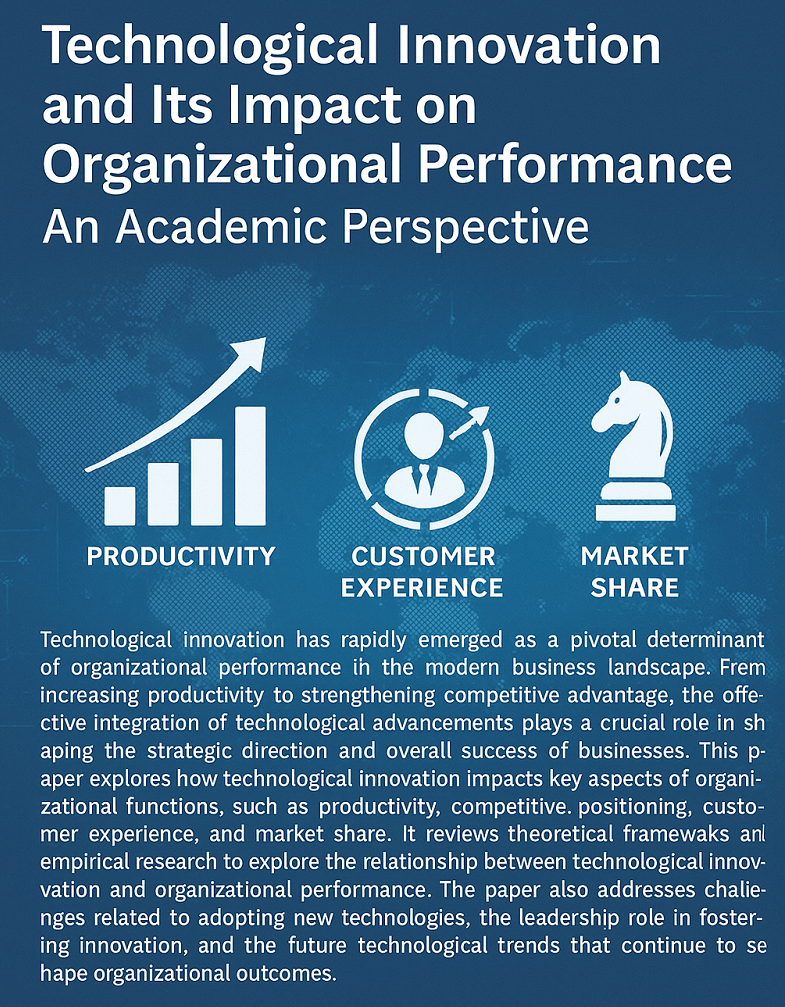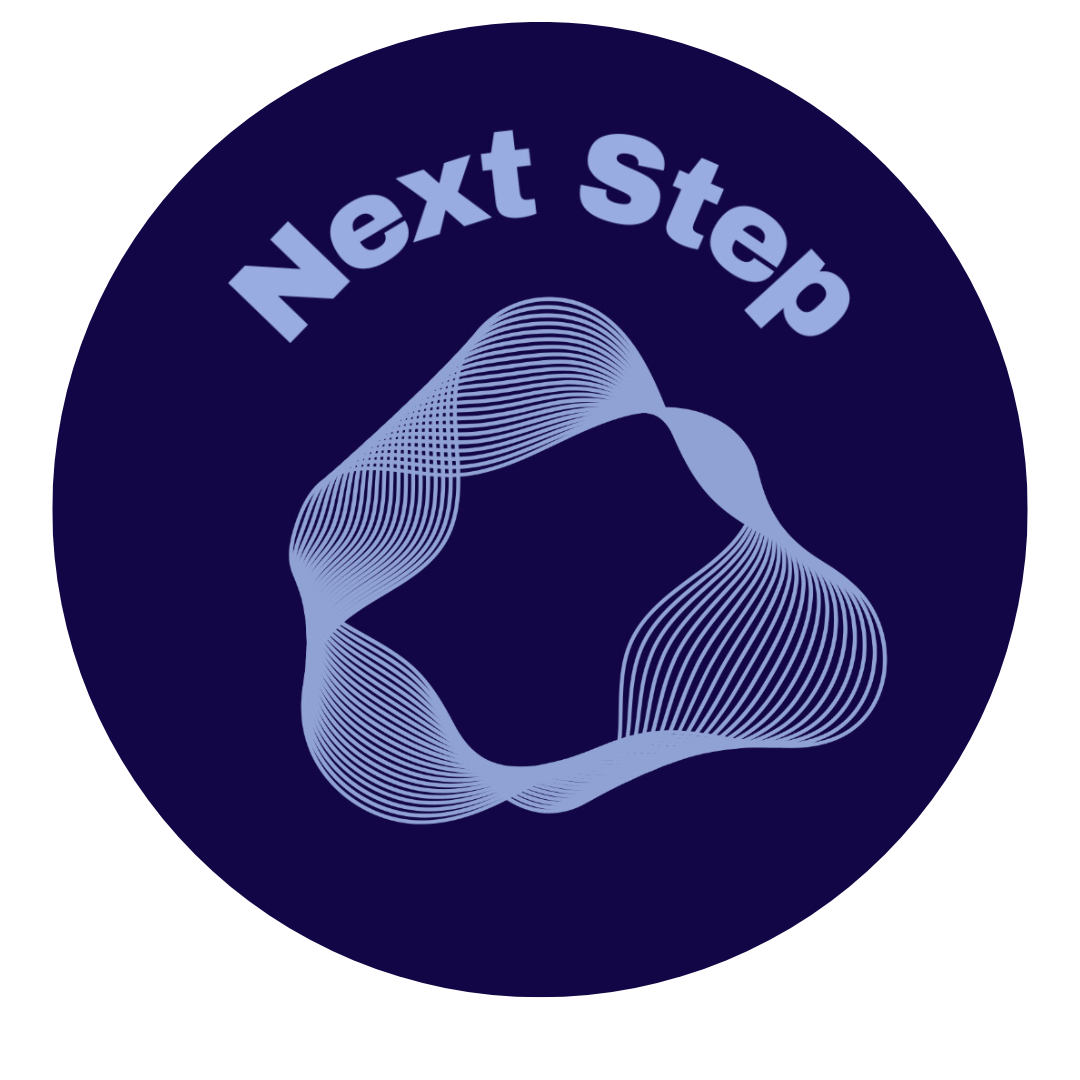Technological Innovation and Its Impact on Organizational Performance: An Academic Perspective
Technological innovation has rapidly emerged as a pivotal determinant of organizational performance in the modern business landscape. From increasing productivity to strengthening competitive advantage, the effective integration of technological advancements plays a crucial role in shaping the strategic direction and overall success of businesses. This paper explores how technological innovation impacts key aspects of organizational functions, such as productivity, competitive positioning, customer experience, and market share. It reviews theoretical frameworks and empirical research to explore the relationship between technological innovation and organizational performance. The paper also addresses challenges related to adopting new technologies, the leadership role in fostering innovation, and the future technological trends that will continue to shape organizational outcomes.
Introduction
The integration of new technologies into business processes is no longer optional but a necessity in today’s fast-paced, highly competitive global market. Technologies such as Artificial Intelligence (AI), automation, blockchain, the Internet of Things (IoT), and advanced data analytics have transformed how organizations operate, enabling them to enhance productivity, lower costs, and maintain a competitive edge. Technological innovation is thus a critical factor in determining an organization’s ability to adapt, survive, and thrive in a rapidly evolving environment.
This paper will analyze the multifaceted impact of technological innovation on organizational performance, drawing on key concepts and literature. The aim is to illustrate how adopting and integrating new technologies can lead to enhanced productivity, innovation capacity, competitive advantage, and overall success.

Theoretical Framework
Technological Innovation: A Definition
Technological innovation refers to the process of introducing new or significantly improved products, services, or business processes, driven by advancements in technology. While this includes the development of entirely new technologies, it also encompasses the creative use of existing technologies to improve organizational operations. Joseph Schumpeter’s theory of creative destruction explains how technological advancements disrupt established business models, enabling new companies or business practices to emerge. Through continuous innovation, firms can secure a competitive edge and redefine industries, even at the risk of upending traditional business operations.
Organizational Performance: A Broader Perspective
Organizational performance is a complex, multidimensional concept. It generally refers to how well an organization achieves its strategic objectives. Common indicators of performance include financial outcomes (e.g., profitability, return on investment), market share, operational efficiency, customer satisfaction, and innovation capacity. In the context of technological innovation, performance is often assessed in terms of how well a company adapts to change, integrates new technologies, and creates new value propositions in the market.
The relationship between technological innovation and organizational performance has been a central concern in strategic management. Today, organizations are expected to leverage technology not just to survive but to thrive by gaining a competitive advantage, optimizing processes, and delivering superior customer value.
Technological Innovation and Its Impact on Organizational Performance
1. Productivity and Operational Efficiency
One of the most immediate and measurable impacts of technological innovation is its ability to enhance organizational productivity. Automation, AI, robotics, and advanced data analytics contribute to more efficient resource management, reduced operational costs, and faster decision-making processes. These technologies also lead to the elimination of redundant tasks and errors, allowing employees to focus on higher-value activities.
For example, Enterprise Resource Planning (ERP) systems and Customer Relationship Management (CRM) software allow organizations to streamline operations, enhance customer interactions, and improve supply chain coordination. Research by Brynjolfsson and Hitt (2003) found that organizations that invest in advanced information technologies significantly increase their productivity in both labor and capital.
However, these productivity benefits are contingent on proper integration and continuous employee training. Simply adopting new technologies without effective implementation can result in missed opportunities for improving operational efficiency.
2. Competitive Advantage
Technological innovation has become a central driver of competitive advantage. Firms that effectively leverage advanced technologies are better positioned to outperform competitors by offering differentiated products, services, and customer experiences. For example, companies like Amazon and Netflix have adopted cloud computing, AI, and big data analytics to personalize customer experiences and optimize supply chains, which has given them a sustainable edge over competitors.
Michael Porter’s value chain framework (1985) illustrates how technological advances in areas such as operations, logistics, and marketing contribute to competitive advantage. By innovating in these areas, companies add value, reduce costs, and improve customer satisfaction, thereby strengthening their position in the market.
In today’s hyper-competitive landscape, if an organization is unwilling or unable to innovate, it risks falling behind competitors that can adapt to new technological trends and meet evolving customer needs more effectively.
3. Innovation Capability and Market Growth
Technological innovation allows organizations to develop an innovation capability—the ability to continuously introduce new products, services, or processes that meet market demands. Firms that invest in research and development (R&D) and adopt innovative technologies are more likely to generate market-leading products that open new revenue streams and foster market growth.
For instance, in the pharmaceutical industry, technological innovations in drug discovery and development have enabled companies to reduce the time and cost of bringing new drugs to market. This accelerates the process of introducing innovative products to consumers, thereby increasing market share and revenue potential.
AI-powered digital marketing platforms have also helped businesses create personalized marketing strategies based on consumer behavior, resulting in more effective customer engagement and enhanced market presence.
4. Customer Satisfaction and Experience
Customer satisfaction has been significantly enhanced through the use of technological innovations. AI, machine learning, and big data analytics allow companies to analyze customer behavior, predict preferences, and deliver customized solutions. This leads to a more personalized experience that drives customer loyalty and repeat business.
For example, Spotify and Netflix use machine learning algorithms to provide users with personalized content recommendations. These tailored experiences not only enhance customer satisfaction but also improve user retention rates, which contribute to market dominance. Companies that effectively exploit technology to anticipate and meet customer needs tend to have a stronger reputation and higher levels of customer satisfaction.
5. Cost Reduction and Efficiency
Cost reduction is another key benefit of technological innovation. Automation, data analytics, and cloud computing enable organizations to cut down on labor costs, minimize human errors, and enhance operational efficiency. For instance, robotics in manufacturing and automated warehouses have drastically reduced costs associated with labor, while improving speed and accuracy in operations.
McKinsey & Company (2019) reported that automation can lead to cost reductions of up to 30% in sectors like manufacturing, healthcare, and logistics. However, these efficiencies can only be realized if the organization can successfully integrate new technologies and ensure that they align with existing business processes.
Challenges of Technological Innovation Implementation
Despite its numerous benefits, the implementation of technological innovation poses several challenges. These challenges include:
1. Resistance to Change
Many employees and managers resist new technologies due to fear of job displacement, lack of technical expertise, or simply a reluctance to adapt to change. Overcoming this resistance requires strong change management strategies that emphasize clear communication, involvement of key stakeholders, and providing adequate training.
2. High Initial Costs and Investment
Technological innovations require substantial investment in infrastructure, software, and employee training. For many small and medium enterprises (SMEs), these costs can be prohibitive. Securing funding for technology adoption may require creative solutions, such as seeking government grants or strategic partnerships.
3. Integration with Existing Systems
Integrating new technologies with legacy systems is often a complex and costly process. Incompatibilities between old and new systems can delay deployment, reduce efficiency, and add unexpected costs. Companies must carefully plan technology integration to minimize disruption to ongoing operations.
4. Cybersecurity Risks
As organizations become more reliant on digital technologies, they face increased risks related to cybersecurity. Data breaches, ransomware attacks, and other cyber threats can undermine the benefits of technological innovation, leading to significant financial losses and reputational damage.
The Role of Leadership in Fostering Technological Innovation
Effective leadership is critical in driving technological innovation within an organization. Leaders must foster a culture that encourages experimentation, collaboration, and risk-taking. Moreover, leaders must be proactive in identifying emerging technologies and integrating them into the company’s strategic vision.
Key Leadership Qualities for Innovation:
-
Openness to Change: Leaders must demonstrate flexibility and a willingness to embrace new ideas and technologies.
-
Strategic Foresight: The ability to anticipate future technological trends and align them with organizational goals.
-
Continuous Learning: Ensuring that employees are continuously trained and equipped to work with emerging technologies.
In conclusion, the future of organizational performance will be largely shaped by the ability of leadership to integrate and leverage new technologies to drive innovation and improve business outcomes.
Emerging Technological Trends
As we look ahead, several technological trends are likely to shape organizational performance in the coming years:
-
Artificial Intelligence (AI) and Machine Learning: AI will continue to optimize decision-making, improve customer personalization, and enhance operational efficiency.
-
IoT (Internet of Things): The widespread use of IoT devices will enable organizations to collect real-time data, optimize asset management, and streamline operations.
-
Blockchain: Blockchain technology will provide enhanced security, transparency, and traceability, especially in industries like supply chain management, finance, and healthcare.
-
5G Connectivity: The arrival of 5G networks will offer faster data transmission, enabling innovations in areas like remote working, smart cities, and autonomous vehicles.
Conclusion
Technological innovation is undeniably a significant driver of organizational performance in the modern business world. Organizations that embrace technology to enhance productivity, improve customer experience, and reduce costs are better positioned to maintain a competitive advantage and achieve long-term success. However, the implementation of new technologies is not without challenges, including resistance to change, high upfront costs, and integration complexities. Effective leadership, strategic foresight, and continuous learning are essential to overcome these obstacles and unlock the full potential of technological innovation.
References
-
Brynjolfsson, E., & Hitt, L. M. (2003). Computing productivity: Firm-level evidence. The Review of Economics and Statistics, 85(4), 793-808.
-
Porter, M. E. (1985). Competitive advantage: Creating and sustaining superior performance. Free Press.
-
McKinsey & Company. (2019). Automation in business: Opportunities and challenges. McKinsey & Company.
-
Hambrick, D. C., & Mason, P. A. (1984). Upper echelons: The organization as a reflection of its top managers. Academy of Management Review, 9(2), 193-206.
